Application of Social Network Analysis in the Economic Connection of Urban Agglomerations Based on Nighttime Lights Remote Sensing: A Case Study in the New Western Land-Sea Corridor, China
Abstract
:1. Introduction
2. Materials and Methods
2.1. Study Area
2.2. Data Sources and Preprocessing
2.3. Methodology
2.3.1. Directional Analysis
2.3.2. Heterogeneity Analysis of Economic Trends
2.3.3. LISA Space-Time Transition Analysis
2.3.4. Economic Connections Analysis
2.3.5. Structure Analysis of Economic Network
2.3.6. Structural Effect Analysis
3. Results
3.1. Economic Distribution of Urban Agglomeration
3.2. Economic Heterogeneity of Urban Agglomerations
3.3. Economic Space-Time Transition of Urban Agglomerations
3.4. Economic Connection of Urban Agglomerations
3.5. Network Structural Characteristics of Urban Agglomerations
3.5.1. Network Density of Economic Connection
3.5.2. Degree Centrality of Economic Connection
3.5.3. Closeness Centrality of Economic Connection
3.5.4. Betweenness Centrality of Economic Connection
3.5.5. Core–Edge Structure of Economic Connection
3.5.6. Structural Hole of Economic Connection
3.6. Economic Connections between Urban Agglomerations
3.6.1. Evolution of Economic Connection
3.6.2. Cohesive Subgroups of the Economic Connection
3.7. Network Structural Effect of Urban Agglomerations
3.7.1. Overall Network Structure Effect
3.7.2. Individual Network Structure Effect
4. Discussion
5. Conclusions and Recommendations
5.1. Conclusions
5.2. Recommendations
Author Contributions
Funding
Informed Consent Statement
Data Availability Statement
Acknowledgments
Conflicts of Interest
References
- Liu, Y.; Zhang, X.; Pan, X.; Ma, X.; Tang, M. The spatial integration and coordinated industrial development of urban agglomerations in the Yangtze River Economic Belt, China. Cities 2020, 104, 102801. [Google Scholar] [CrossRef]
- Qin, X.; Qian, Y.; Zeng, J.; Wei, X. Accessibility and economic connections between cities of the new western land–sea corridor in china—enlightenments to the passageway strategy of gansu province. Sustainability 2022, 14, 4445. [Google Scholar] [CrossRef]
- Chen, H.; Dong, Q. The spatial difference and impact effect of urban innovation at the new Western Land–Sea corridor. J. Chongqing Univ. Technol. (Soc. Sci.) 2021, 35, 58–67. [Google Scholar]
- Matthieu, C.; Pamina, K. Structural gravity equations with intensive and extensive margins. Can. J. Econ. 2010, 43, 41–62. [Google Scholar]
- Zipf, G.K. The PIP2/D hypothesis: On the Intercity movement of persons. Am. Sociol. Rev. 1946, 11, 677–686. [Google Scholar] [CrossRef]
- Xie, W.; Li, H.; Yin, Y. Research on the Spatial Structure of the European Union’s Tourism Economy and Its Effects. Int. J. Environ. Res. Public Health 2021, 18, 1389. [Google Scholar] [CrossRef]
- Chen, X.; Wang, T.; Zheng, X.; Han, F.; Yang, Z. The structure and evolution of the tourism economic network of the Tibetan Plateau and its driving factors. Land 2022, 11, 241. [Google Scholar] [CrossRef]
- Huang, Y.; Hong, T.; Ma, T. Urban network externalities, agglomeration economies and urban economic growth. Cities 2020, 107, 102882. [Google Scholar] [CrossRef]
- Wang, K.; Wang, M.; Gan, C.; Chen, Q.; Voda, M. Tourism economic network structural characteristics of national parks in the central region of China. Sustainability 2021, 13, 4805. [Google Scholar] [CrossRef]
- Wang, F.; Chai, W.; Shi, X.; Dong, M.; Yan, B. Does regional financial resource contribute to economic growth? From the perspective of spatial correlation network. SAGE Open 2021, 11. [Google Scholar] [CrossRef]
- Ye, S.; Qian, Z. The economic network resilience of the Guanzhong Plain City Cluster, China: A network analysis from the evolutionary perspective. Growth Change 2021, 52, 2391–2411. [Google Scholar] [CrossRef]
- Jin, R.; Gong, J.; Deng, M.; Wan, Y.; Yang, X. A framework for spatiotemporal analysis of regional economic agglomeration patterns. Sustainability 2018, 10, 2800. [Google Scholar] [CrossRef]
- Zhao, X.; Su, J.; Chao, J.; Liu, X.; Li, T.; Rui, Y.; Yang, J. The character and economic preference of city network of china: A study based on the Chinese global fortune 500 enterprises. Complexity 2020, 2020, 4312578. [Google Scholar] [CrossRef]
- Zheng, Y.; Lu, M.; Li, J. Internal circulation in China: Analyzing market segmentation and integration using big data for truck traffic flow. Econ. Model. 2022, 115, 105975. [Google Scholar] [CrossRef]
- Zhu, Z.; Wang, L.; Liu, W.; Qi, D. Relationship between urban economic connections and geoeconomic relations in northeast China. Complexity 2020, 2020, 5263048. [Google Scholar] [CrossRef]
- Yu, G.; He, D.; Lin, W.; Wu, Q.; Xiao, J.; Lei, X.; Xie, Z.; Wu, R.; Jaramillo, S.M. China’s spatial economic network and its influencing factors. Complexity 2020, 2020, 6352021. [Google Scholar] [CrossRef]
- Chen, Y.; Jiang, A. Spatial characteristics and complexity of the urban economic network structure based on the secure internet of things. Sustain. Comput. Inf. Syst. 2022, 35, 100729. [Google Scholar] [CrossRef]
- Wang, H.; Kilmartin, L. Comparing rural and urban social and economic behavior in Uganda: Insights from mobile voice service usage. J. Urban Technol. 2014, 21, 61–89. [Google Scholar] [CrossRef]
- Chu, N.; Zhang, P.; Li, H. Transnational economic connection analysis based on railway class accessibility between China and Russia. Chin. Geogr. Sci. 2019, 29, 872–886. [Google Scholar] [CrossRef] [Green Version]
- Li, M.; Guo, W.; Guo, R.; He, B.; Li, Z.; Li, X.; Liu, W.; Fan, Y. Urban network spatial connection and structure in China based on railway passenger flow big data. Land 2022, 11, 225. [Google Scholar] [CrossRef]
- Jiang, J.; Chen, J.; Tu, W.; Wang, C. A Novel effective indicator of weighted inter-city human mobility networks to estimate economic development. Sustainability 2019, 11, 6348. [Google Scholar] [CrossRef] [Green Version]
- Hu, S.; Yang, H.; Cai, B.; Yang, C. Research on spatial economic structure for different economic sectors from a perspective of a complex network. Phys. A 2013, 392, 3682–3697. [Google Scholar] [CrossRef]
- Sylvain, D. The role of distance and social networks in the geography of crowdfunding: Evidence from France. Reg. Stud. 2019, 54, 329–339. [Google Scholar]
- Gan, C.; Voda, M.; Wang, K.; Chen, L.; Ye, J. Spatial network structure of the tourism economy in urban agglomeration: A social network analysis. J. Hosp. Tour. Manag. 2021, 47, 124–133. [Google Scholar] [CrossRef]
- Feng, R.; Wang, K. Spatiotemporal evolution of the constraint strength of “administrative regional economy” from the perspective of regional economic integration: A case study of the Chengdu-Deyang-Mianyang region, China. Prog. Geogr. 2020, 39, 1447–1459. (In Chinese) [Google Scholar] [CrossRef]
- Wu, S.; Zhong, Y.; Wu, Q.; Mao, W. Multi-outward connection networks of urban agglomeration: An empirical study from middle reaches of yangtze river to yangtze river economic belt. Resour. Environ. Yangtze Basin 2021, 30, 2360–2372. (In Chinese) [Google Scholar]
- Kim, A.C.H.; Newman, J.I.; Kwon, W. Developing community structure on the sidelines: A social network analysis of youth sport league parents. Soc. Sci. J. 2020, 57, 178–194. [Google Scholar] [CrossRef]
- Jinliao, H.; Xianpeng, W.; Gang, Z. Creative city networks: A social network analysis of a virtual community of designers in China. Cities 2022, 123, 103578. [Google Scholar] [CrossRef]
- Lu, W.; Park, S.H.; Liu, S.; Nam, T.H.; Yeo, G.T. Connection analysis of container ports of the bohai rim economic circle (BREC). Asian J. Shipping Log. 2018, 34, 145–150. [Google Scholar] [CrossRef]
- Guo, Y.; Cao, L.; Song, Y.; Wang, Y.; Li, Y. Understanding the formation of City-HSR network: A case study of Yangtze River Delta, China. Transp. Policy 2022, 116, 315–326. [Google Scholar] [CrossRef]
- Huang, X.; Li, G.; Song, Y.; Liu, J. The impact of spatial structure on economic efficiency of Beijing-Tianjin-Hebei megalopolis in China. Complexity 2020, 2020, 6038270. [Google Scholar] [CrossRef]
- Sun, Q.; Tang, F.; Tang, Y. An economic tie network-structure analysis of urban agglomeration in the middle reaches of Changjiang River based on SNA. J. Geogr. Sci. 2015, 25, 739–755. [Google Scholar] [CrossRef] [Green Version]
- Croft, T.A. Nighttime images of the earth from space. Sci. Am. 1978, 239, 86–101. [Google Scholar] [CrossRef]
- Ch, R.; Martin, D.A.; Vargas, J.F. Measuring the size and growth of cities using nighttime light. J. Urban. Econ. 2021, 125, 103254. [Google Scholar] [CrossRef]
- Yu, M.; Guo, S.; Guan, Y.; Cai, D.; Zhang, C.; Fraedrich, K.; Liao, Z.; Zhang, X.; Tian, Z. Spatiotemporal heterogeneity analysis of Yangtze River Delta urban agglomeration: Evidence from nighttime light data (2001–2019). Remote Sens. 2021, 13, 1235. [Google Scholar] [CrossRef]
- Fu, H.; Shao, Z.; Fu, P.; Cheng, Q. The dynamic analysis between urban nighttime economy and urbanization using the DMSP/OLS nighttime light data in china from 1992 to 2012. Remote Sens. 2017, 9, 416. [Google Scholar] [CrossRef] [Green Version]
- Keola, S.; Andersson, M.; Hall, O. Monitoring economic development from space: Using nighttime light and land cover data to measure economic growth. World Dev. 2015, 66, 322–334. [Google Scholar] [CrossRef]
- Liu, S.; Shi, K.; Wu, Y.; Chang, Z. Remotely sensed nighttime lights reveal China’s urbanization process restricted by haze pollution. Transp. Policy 2021, 206, 108350. [Google Scholar] [CrossRef]
- Alahmadi, M.; Atkinson, P.M. Three-fold urban expansion in Saudi Arabia from 1992 to 2013 observed using calibrated DMSP-OLS night-time lights imagery. Remote Sens. 2019, 11, 2266. [Google Scholar] [CrossRef] [Green Version]
- Alahmadi, M.; Mansour, S.; Martin, D.; Atkinson, P.M. An improved index for urban population distribution mapping based on nighttime lights (DMSP-OLS) data: An experiment in Riyadh Province, Saudi Arabia. Remote Sens. 2021, 13, 1171. [Google Scholar] [CrossRef]
- Chen, X.; Nordhaus, W.D. VIIRS nighttime lights in the estimation of cross-sectional and time-series GDP. Remote Sens. 2019, 11, 1057. [Google Scholar] [CrossRef] [Green Version]
- Yin, J.; Qiu, Y.; Zhang, B. Identification of poverty areas by remote sensing and machine learning: A case study in Guizhou, Southwest China. ISPRS Int. J. Geo-Inf. 2020, 10, 11. [Google Scholar] [CrossRef]
- Weidmann, N.B.; Theunissen, G. Estimating local inequality from nighttime lights. Remote Sens. 2021, 13, 4624. [Google Scholar] [CrossRef]
- Chen, Z.; Wei, Y.; Shi, K.; Zhao, Z.; Wang, C.; Wu, B.; Qiu, B.; Yu, B. The potential of nighttime light remote sensing data to evaluate the development of digital economy: A case study of China at the city level. Comput. Environ. Urban Syst. 2022, 92, 101749. [Google Scholar] [CrossRef]
- Cui, Y.; Shi, K.; Jiang, L.; Qiu, L.; Wu, S. Identifying and evaluating the nighttime economy in China using multisource data. IEEE Geosci. Remote Sens. Lett. 2021, 18, 1906–1910. [Google Scholar] [CrossRef]
- Chen, Z.; Yu, B.; Yang, C.; Zhou, Y.; Yao, S.; Qian, X.; Wang, C.; Wu, B.; Wu, J. An extended time series (2000–2018) of global NPP-VIIRS-like nighttime light data from a cross-sensor calibration. Earth Sys. Sci. Data 2021, 13, 889–906. [Google Scholar] [CrossRef]
- Li, Y.; Ye, H.; Gao, X.; Sun, D.; Li, Z.; Zhang, N.; Leng, X.; Meng, D.; Zheng, J. Spatiotemporal Patterns of urbanization in the three most developed urban agglomerations in China based on continuous nighttime light data (2000–2018). Remote Sens. 2021, 13, 2245. [Google Scholar] [CrossRef]
- Gibson, J.; Boe-Gibson, J. Nighttime Lights and County-Level Economic Activity in the United States: 2001 to 2019. Remote Sens. 2021, 13, 2741. [Google Scholar] [CrossRef]
- Li, X.; Xu, H.; Chen, X.; Li, C. Potential of NPP-VIIRS nighttime light imagery for modeling the regional economy of China. Remote Sens. 2013, 5, 3057–3081. [Google Scholar] [CrossRef] [Green Version]
- Zhang, Q.; Seto, K.C. Mapping urbanization dynamics at regional and global scales using multi-temporal DMSP/OLS nighttime light data. Remote Sens. Environ. 2011, 115, 2320–2329. [Google Scholar] [CrossRef]
- Li, Y.; Zuo, Z.; Xu, D.; Wei, Y. Mining eco-efficiency measurement and driving factors identification based on Meta-US-SBM in Guangxi Province, China. Int. J. Environ. Res. Public Health 2021, 18, 5397. [Google Scholar] [CrossRef] [PubMed]
- Qiu, Y.; Yin, J.; Zhang, T.; Du, Y.; Zhang, B. Spatiotemporal dynamic analysis of a-level scenic spots in Guizhou Province, China. ISPRS Int. J. Geo-Inf. 2021, 10, 568. [Google Scholar] [CrossRef]
- Aghadadashi, V.; Molaei, S.; Mehdinia, A.; Mohammadi, J.; Moeinaddini, M.; Riyahi Bakhtiari, A. Using GIS, geostatistics and Fuzzy logic to study spatial structure of sedimentary total PAHs and potential eco-risks; An Eastern Persian Gulf case study. Mar. Pollut. Bull. 2019, 149, 110489. [Google Scholar] [CrossRef] [PubMed]
- Rey, S.J.; Murray, A.T.; Anselin, L. Visualizing regional income distribution dynamics. Lett. Spat. Resour. Sci. 2011, 4, 81–90. [Google Scholar] [CrossRef]
- Zhang, B.; Yin, J.; Jiang, H.; Qiu, Y. Spatial–temporal pattern evolution and influencing factors of coupled coordination between carbon emission and economic development along the Pearl River Basin in China. Environ. Sci. Pollut. Res. 2022. [Google Scholar] [CrossRef]
- Ye, X.; Rey, S. A framework for exploratory space-time analysis of economic data. Ann. Regional Sci. 2011, 50, 315–339. [Google Scholar] [CrossRef]
- Jiang, H.; Yin, J.; Qiu, Y.; Zhang, B.; Ding, Y.; Xia, R. Industrial carbon emission efficiency of cities in the pearl river basin: Spatiotemporal dynamics and driving forces. Land 2022, 11, 1129. [Google Scholar] [CrossRef]
- Pei, Z.; Han, G.; Ma, X.; Shi, T.; Gong, W. A Method for estimating the background column concentration of CO2 using the lagrangian. IEEE Trans. Geosci. Remote Sens. 2022, 60, 4108112. [Google Scholar] [CrossRef]
- Fan, Y.; Zhang, S.; He, Z.; He, B.; Yu, H.; Ye, X.; Yang, H.; Zhang, X.; Chi, Z. Spatial pattern and evolution of urban system based on gravity model and whole network analysis in the huaihe river basin of China. Discrete Dyn. Nat. Soc. 2018, 2018, 3698071. [Google Scholar] [CrossRef]
- Liu, Z.; Mu, R.; Hu, S.; Li, M.; Wang, L. The method and application of graphic recognition of the social network structure of urban agglomeration. Wirel. Pers. Commun. 2018, 103, 447–480. [Google Scholar] [CrossRef]
- Li, X.; Lu, Y.; Huang, R. Whether foreign direct investment can promote high-quality economic development under environmental regulation: Evidence from the Yangtze River Economic Belt, China. Environ. Sci. Pollut. Res. 2021, 28, 21674–21683. [Google Scholar] [CrossRef] [PubMed]
- Kong, Q.; Peng, D.; Ni, Y.; Jiang, X.; Wang, Z. Trade openness and economic growth quality of China: Empirical analysis using ARDL model. Financ. Res. Lett. 2021, 38, 101488. [Google Scholar] [CrossRef]
- Peng, B.; Sheng, X.; Wei, G. Does environmental protection promote economic development? From the perspective of coupling coordination between environmental protection and economic development. Environ. Sci. Pollut. Res. 2020, 27, 39135–39148. [Google Scholar] [CrossRef] [PubMed]
- Esteves, R.; Geisler Mesevage, G. Social networks in economic history: Opportunities and challenges. Explor. Econ. Hist. 2019, 74, 101299. [Google Scholar]
- Bai, C.; Zhou, L.; Xia, M.; Feng, C. Analysis of the spatial association network structure of China’s transportation carbon emissions and its driving factors. J. Environ. Manag. 2020, 253, 109765. [Google Scholar] [CrossRef] [PubMed]
- Lovrić, M.; Da Re, R.; Vidale, E.; Pettenella, D.; Mavsar, R. Social network analysis as a tool for the analysis of international trade of wood and non-wood forest products. For. Policy Econ. 2018, 86, 45–66. [Google Scholar] [CrossRef]
- Song, J.; Feng, Q.; Wang, X.; Fu, H.; Jiang, W.; Chen, B. Spatial association and effect evaluation of CO2 emission in the Chengdu-Chongqing urban agglomeration: Quantitative evidence from social network analysis. Sustainability 2018, 11, 1. [Google Scholar] [CrossRef] [Green Version]
- Zhu, S.; Kou, M.; Lai, F.; Feng, Q.; Du, G. The connectedness of the coronavirus disease pandemic in the world: A study based on complex network analysis. Front. Phys. 2021, 8, 602075. [Google Scholar] [CrossRef]
- Saglietto, L.; Cézanne, C.; David, D. Research on structural holes: An assessment on measurement issues. J. Econ. Surv. 2020, 34, 572–593. [Google Scholar] [CrossRef]
- Stoltenberg, D.; Maier, D.; Waldherr, A. Community detection in civil society online networks: Theoretical guide and empirical assessment. Soc. Netw. 2019, 59, 120–133. [Google Scholar] [CrossRef]
- Shen, X.; Aliko, S.; Han, Y.; Skipper, J.I.; Peng, C. Finding core-periphery structures with node influences. IEEE Trans. Netw. Sci. Eng. 2022, 9, 875–887. [Google Scholar] [CrossRef]
- Wang, W.; He, J.; Feng, H.; Jin, Z. High-coverage reconstruction of XCO2 using multisource satellite remote sensing data in Beijing-Tianjin-Hebei region. Int. J. Environ. Res. Public Health. 2022, 19, 10853. [Google Scholar] [CrossRef] [PubMed]
- Xu, W.; Wang, W.; Wang, N.; Chen, B. A new algorithm for himawari-8 aerosol optical depth retrieval by integrating regional PM2.5 concentrations. IEEE Trans. Geosci. Remote Sens. 2022, 60, 4106711. [Google Scholar] [CrossRef]
- Gibson, J.; Olivia, S.; Boe-Gibson, G.; Li, C. Which night lights data should we use in economics, and where? J. Dev. Econ. 2021, 149, 102602. [Google Scholar] [CrossRef]
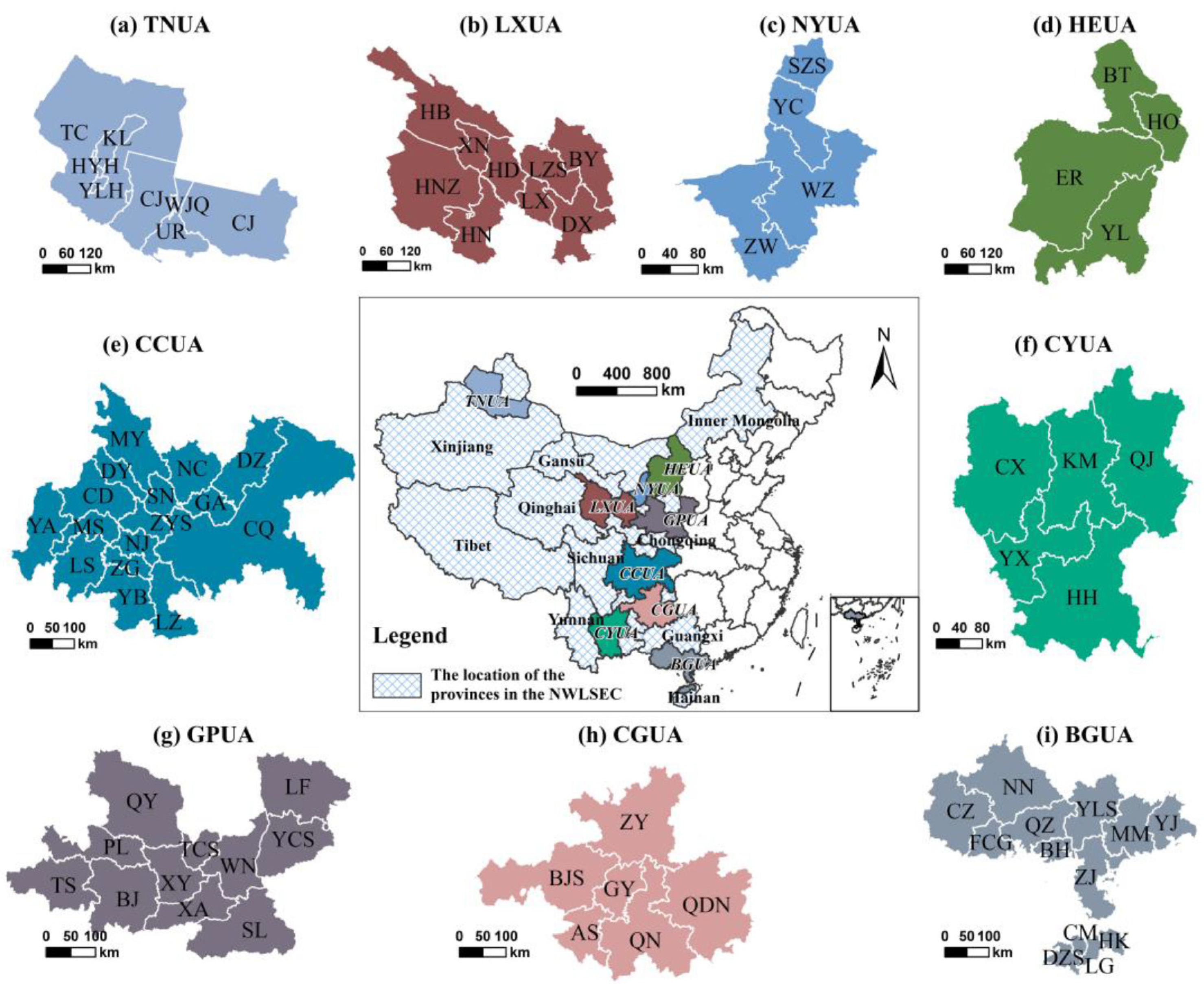

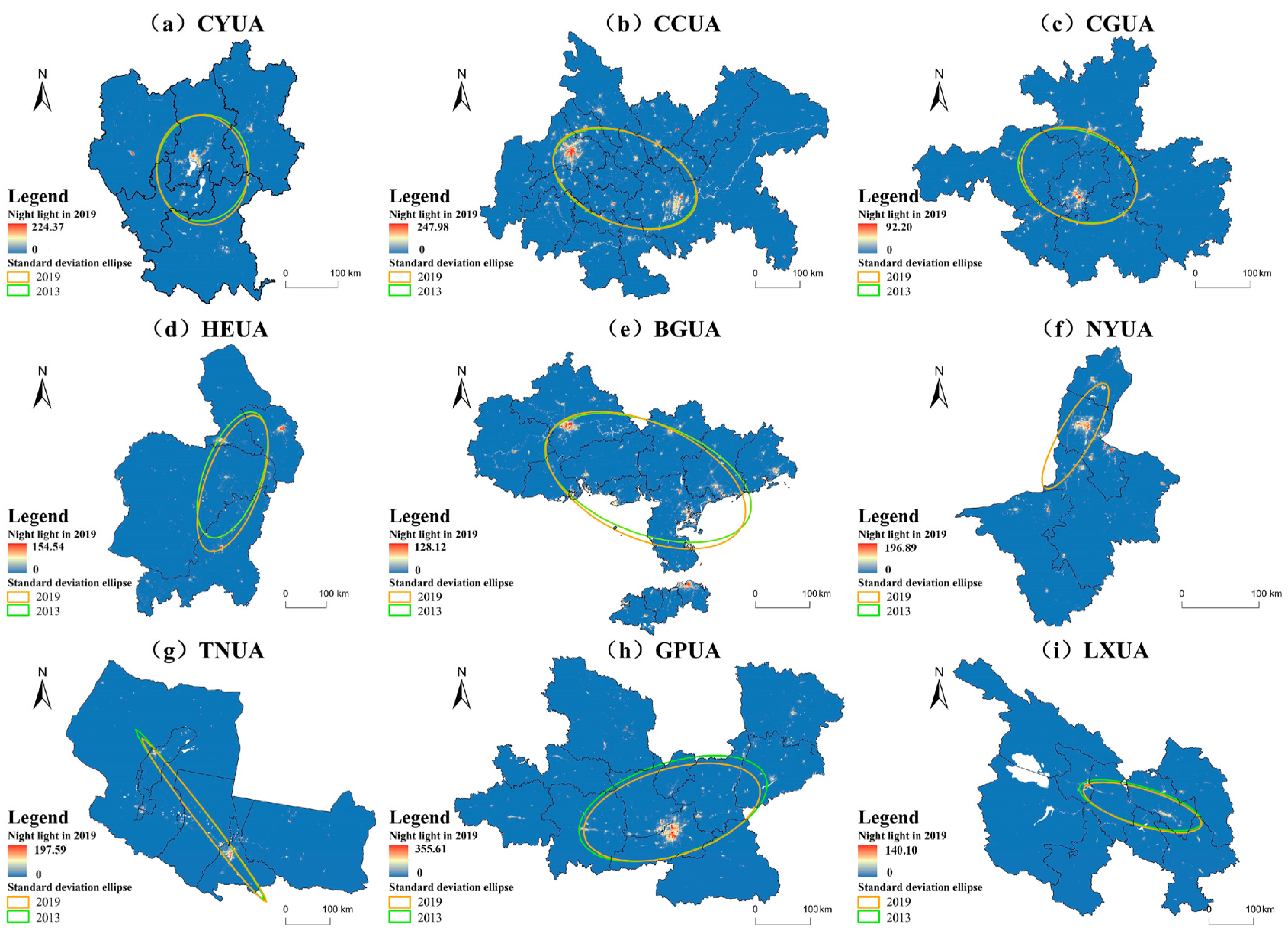
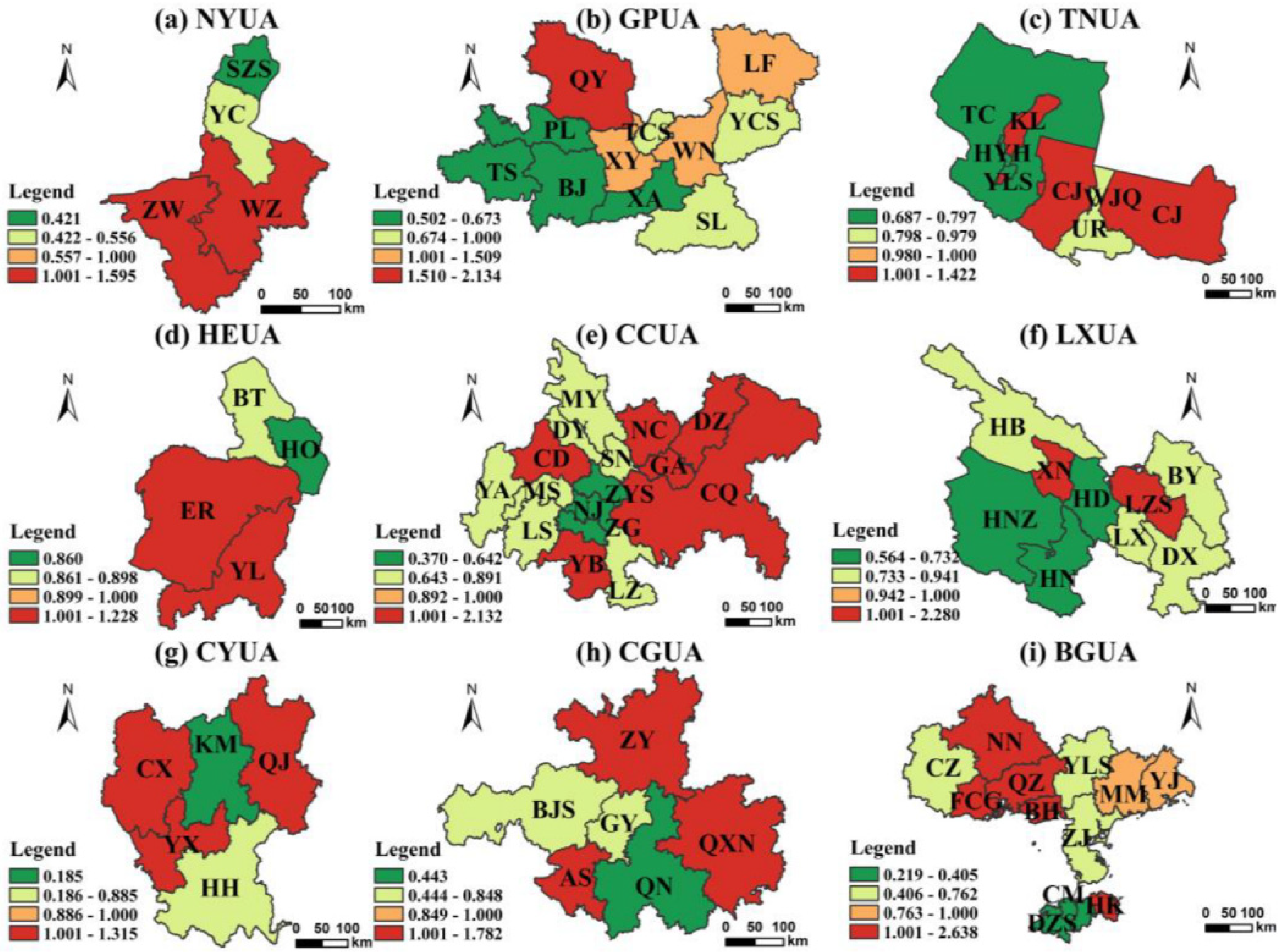
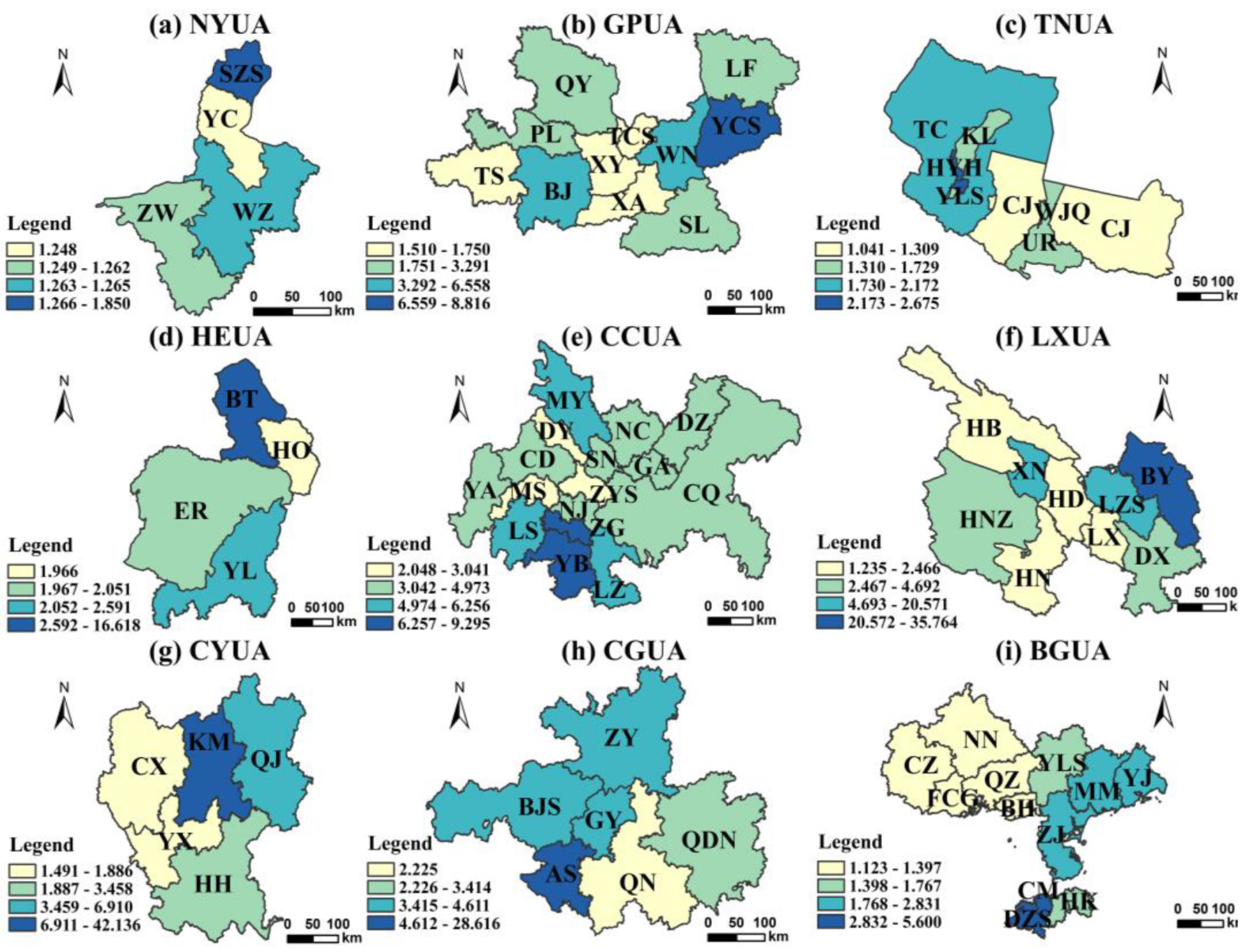
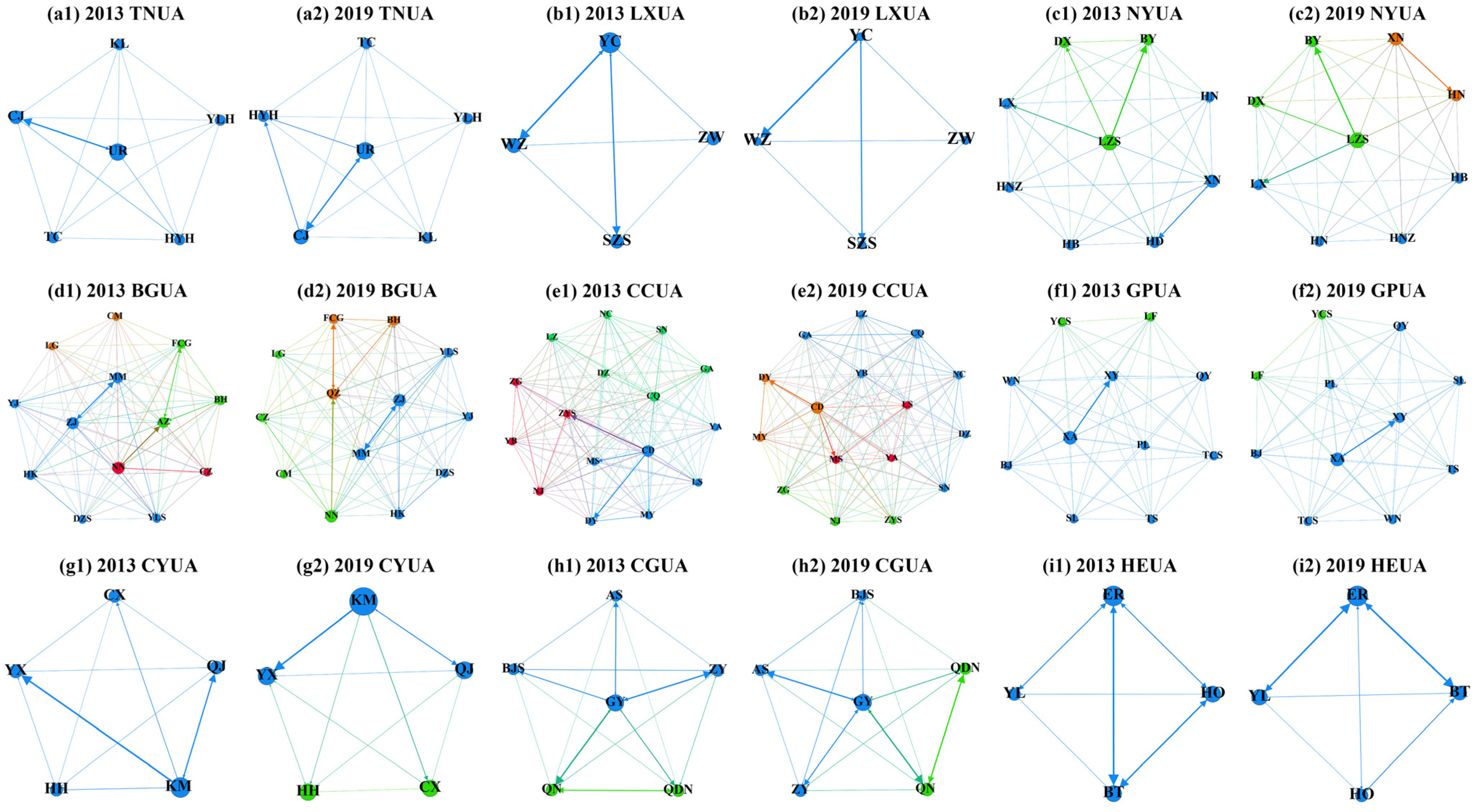
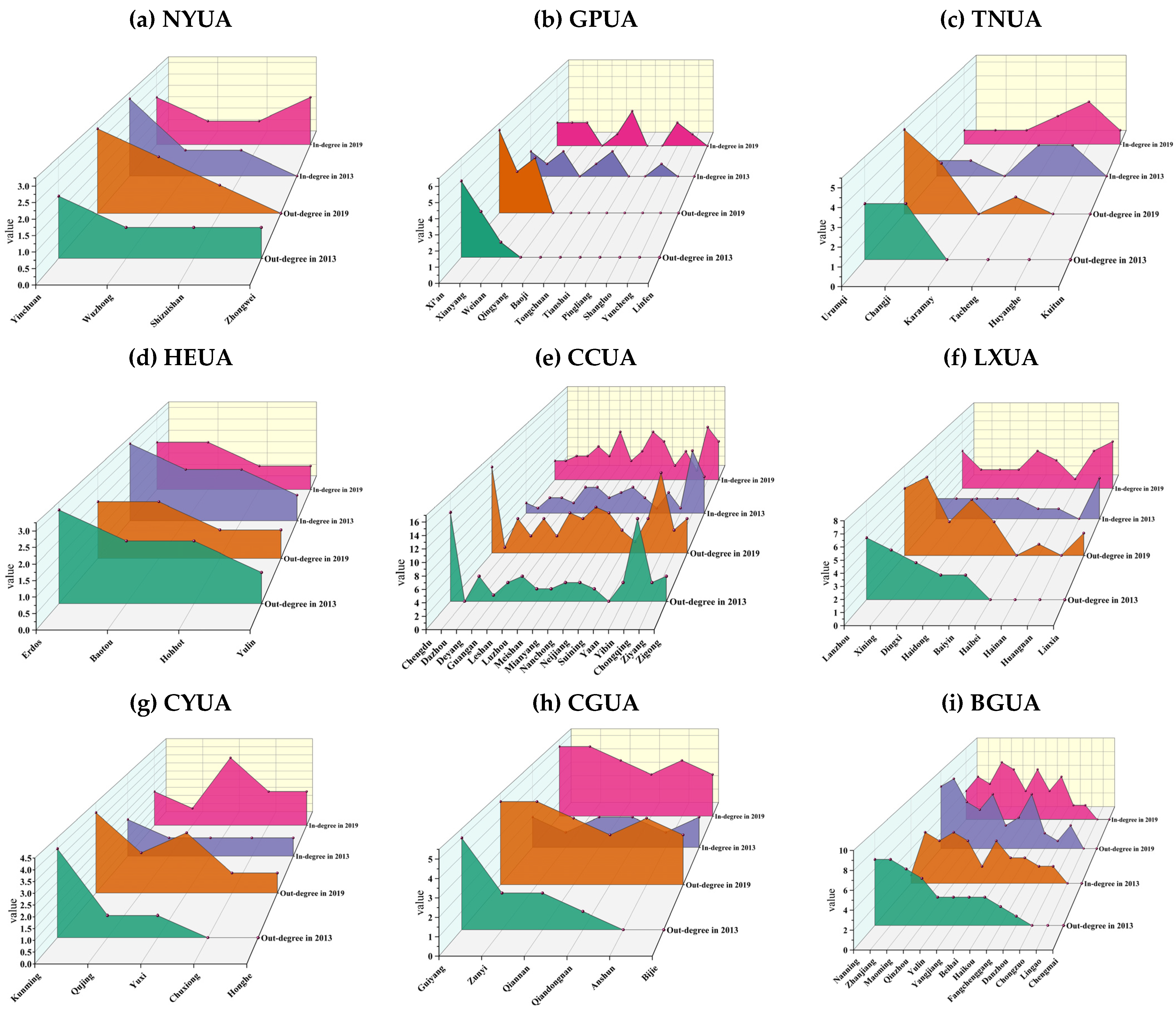
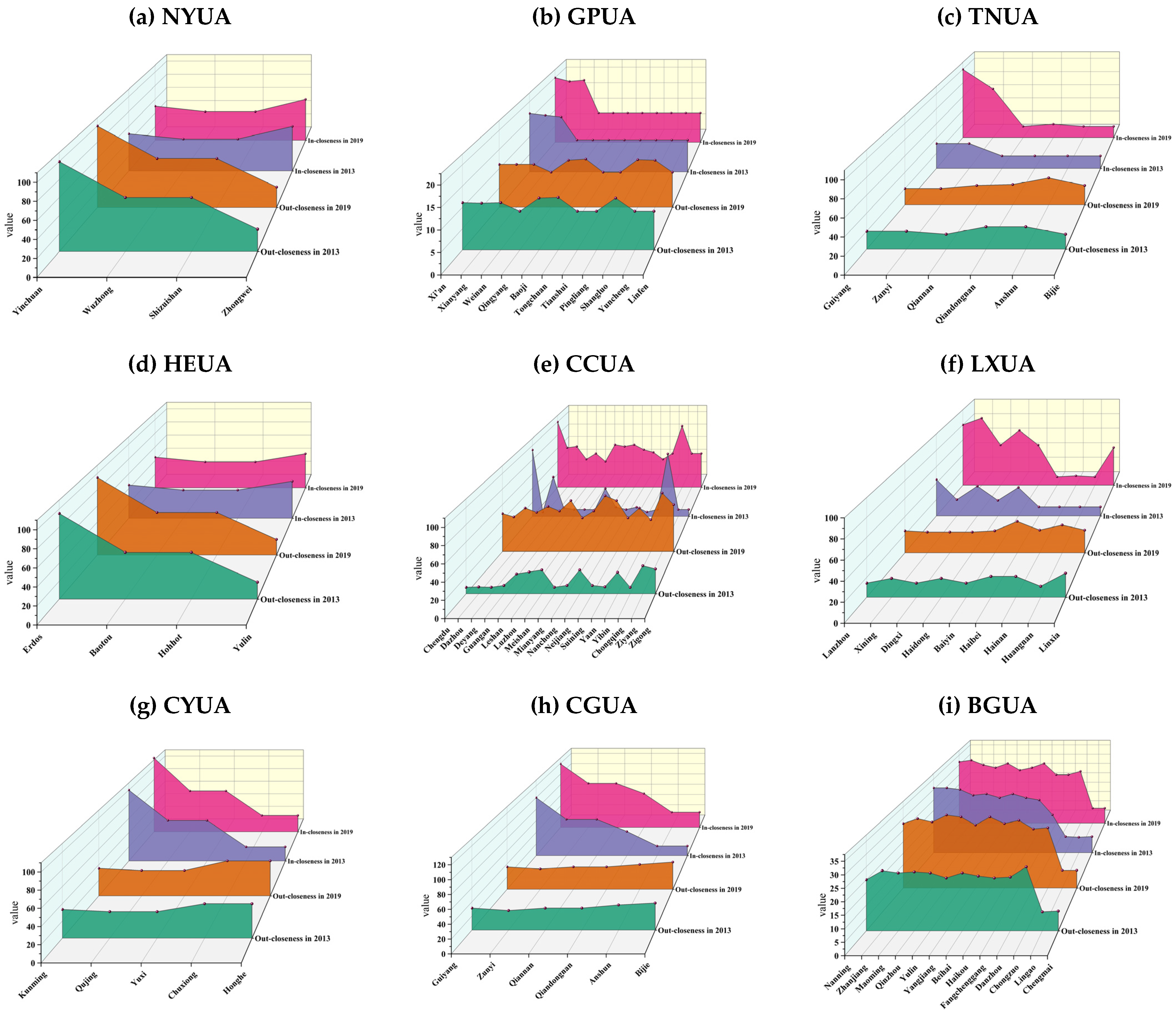
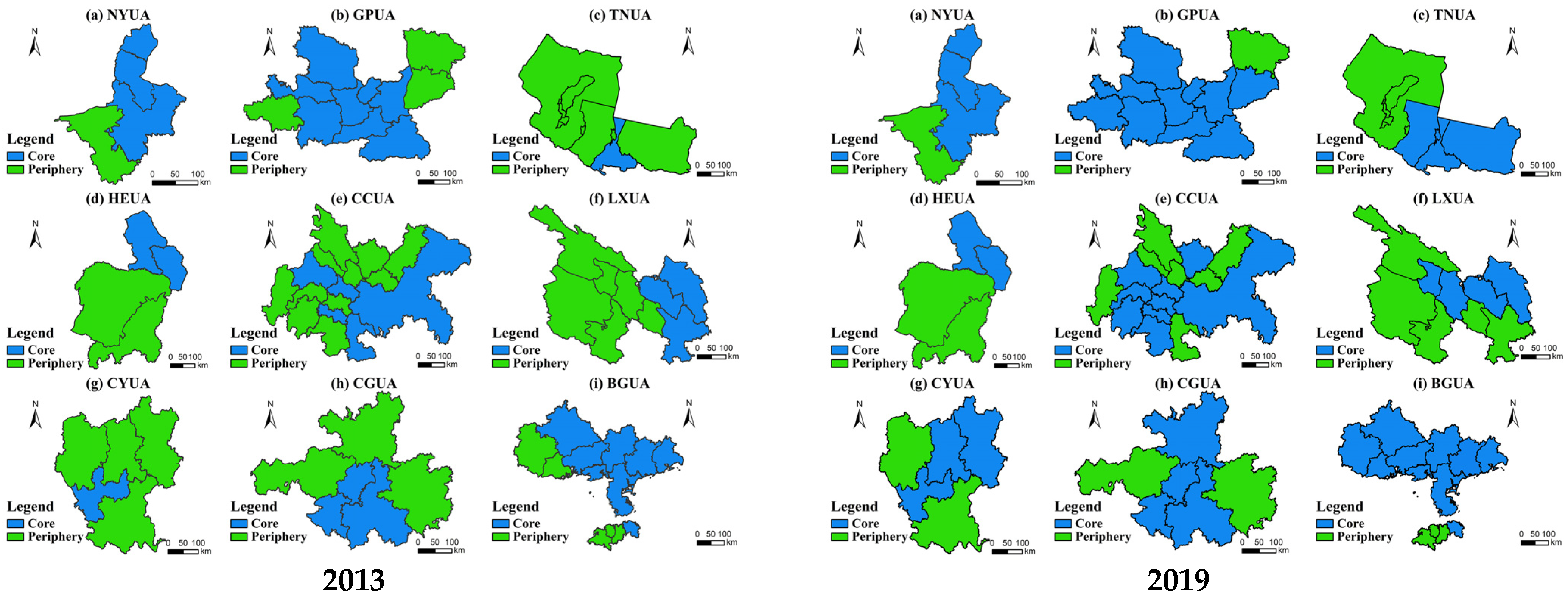
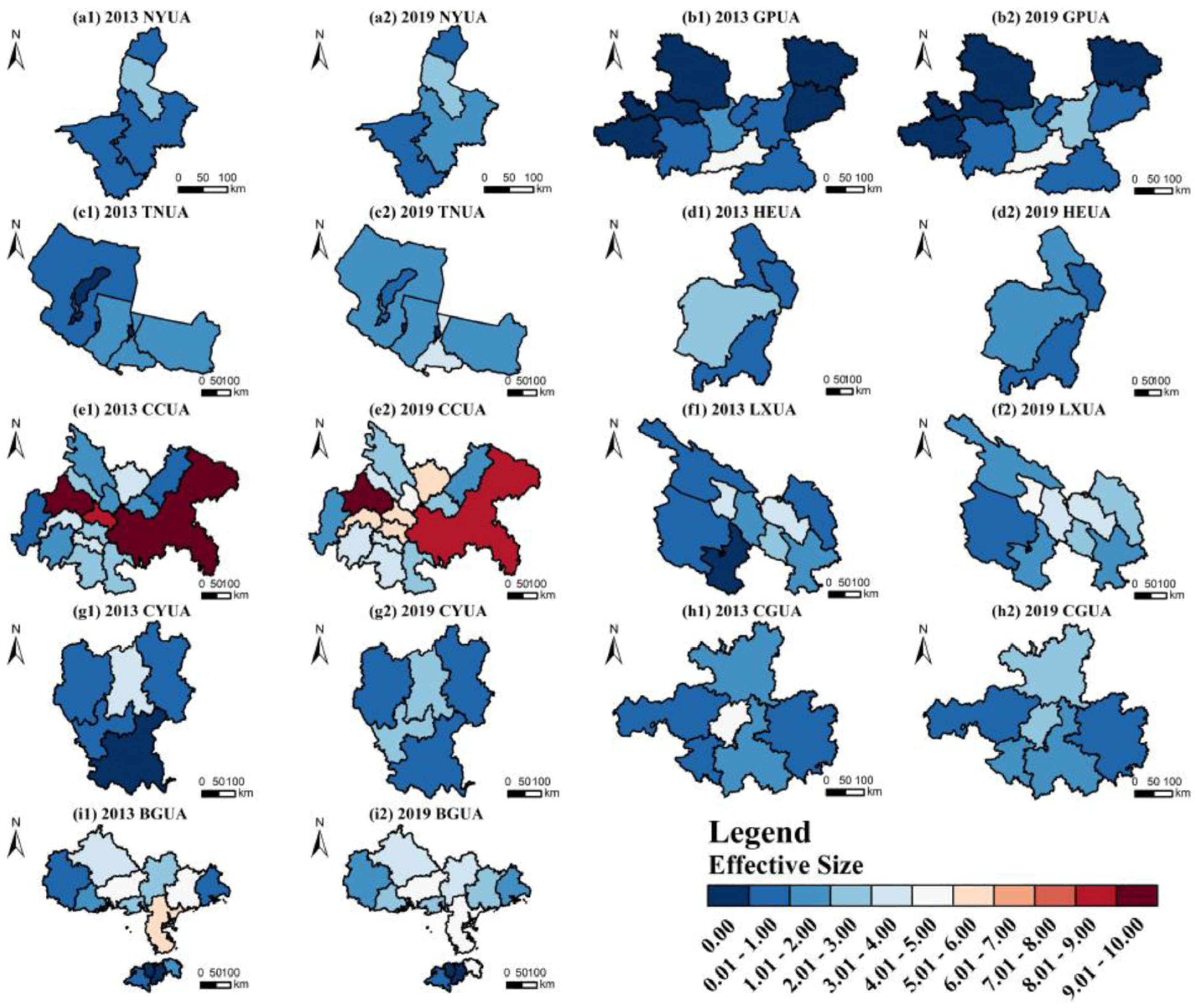
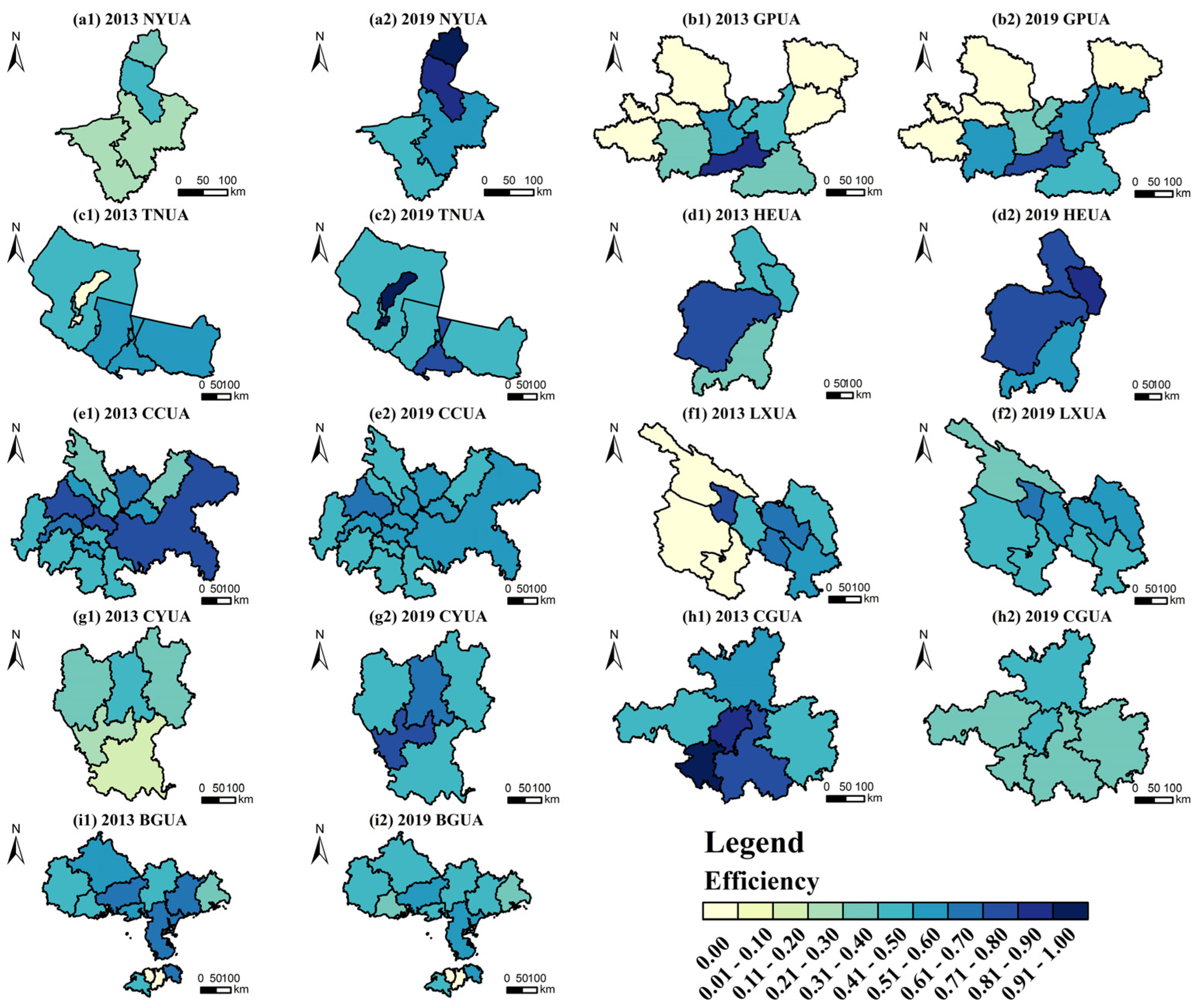
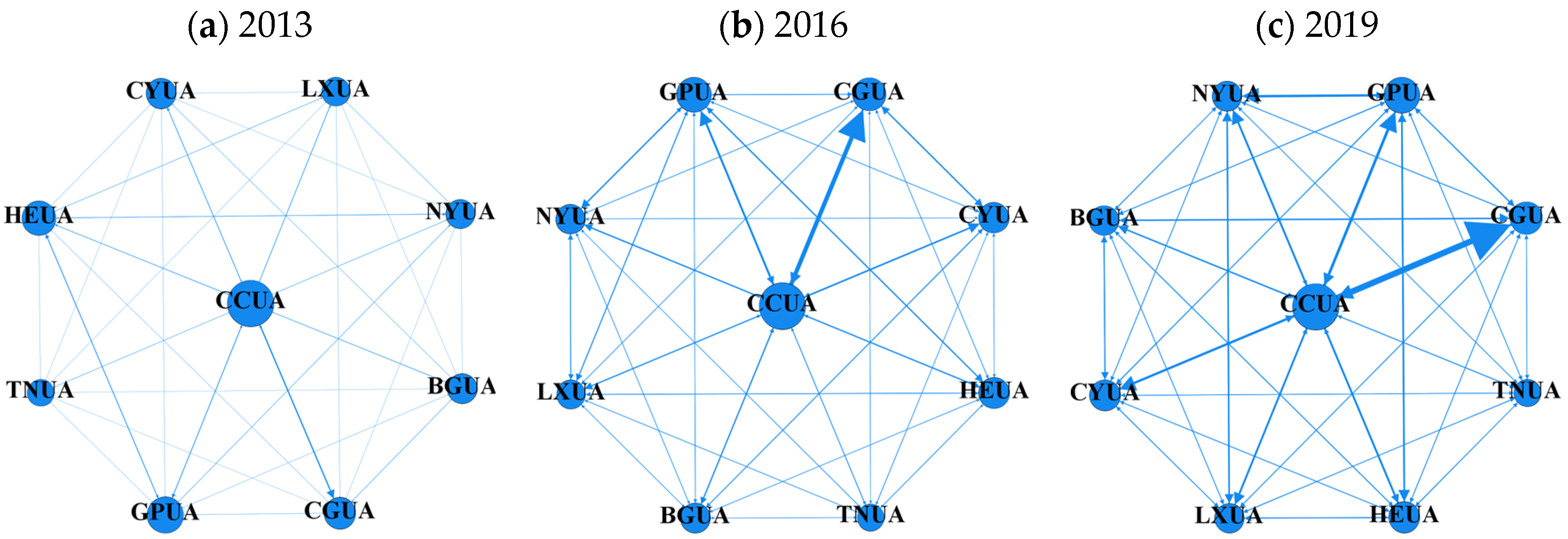
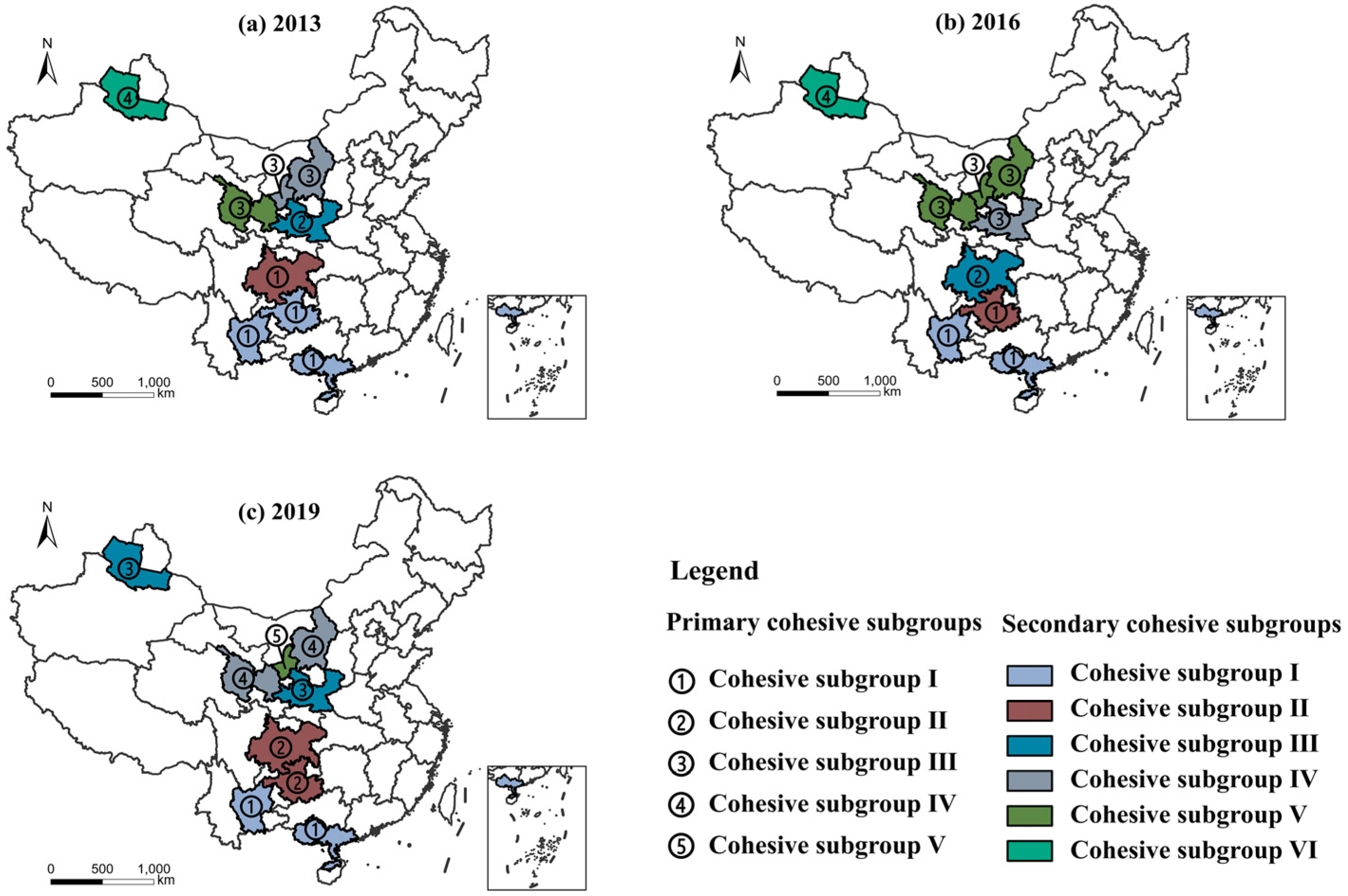
| Urban Agglomeration | City | Symbol | Urban Agglomeration | City | Symbol |
|---|---|---|---|---|---|
| Ningxia urban agglomeration along the Yellow River | Yinchuan | YC | Hohhot–Baotou–Ordos–Yulin urban agglomeration | Erdos | ER |
| Wuzhong | WZ | Baotou | BT | ||
| Shizuishan | SZS | Hohhot | HO | ||
| Zhongwei | ZW | Yulin | YL | ||
| Guanzhong Plain urban agglomeration | Xi’an | XA | Beibu Gulf urban agglomeration | Nanning | NN |
| Xianyang | XY | Zhanjiang | ZJ | ||
| Weinan | WN | Maoming | MM | ||
| Qingyang | QY | Qinzhou | QZ | ||
| Baoji | BJ | Yulin | YLS | ||
| Tongchuan | TCS | Yangjiang | YJ | ||
| Tianshui | TS | Beihai | BH | ||
| Pingliang | PL | Haikou | HK | ||
| Shangluo | SL | Fangchenggang | FCG | ||
| Yuncheng | YCS | Danzhou | DZS | ||
| Linfen | LF | Chongzuo | CZ | ||
| Chengdu–Chongqing urban agglomeration | Chengdu | CD | Lanzhou–Xining urban agglomeration LXUA | Lanzhou | LZS |
| Dazhou | DZ | Xining | XN | ||
| Deyang | DY | Dingxi | DX | ||
| Guangan | GA | Haidong | HD | ||
| Leshan | LS | Baiyin | BY | ||
| Luzhou | LZ | Haibei | HB | ||
| Meishan | MS | Hainan | HNZ | ||
| Mianyang | MY | Huangnan | HN | ||
| Nanchong | NC | Linxia | LX | ||
| Neijiang | NJ | central Guizhou urban agglomeration | Guiyang | GY | |
| Suining | SN | Zunyi | ZY | ||
| Yaan | YA | Qiannan | QN | ||
| Yibin | YB | Qiandongnan | QDN | ||
| Chongqing | CQ | Anshun | AS | ||
| Ziyang | ZYS | Bijie | BJS | ||
| Zigong | ZG | Tianshan North slope urban agglomeration | Urumqi | UR | |
| central Yunnan urban agglomeration | Kunming | KM | Changji | CJ | |
| Qujing | QJ | Karamay | KL | ||
| Yuxi | YX | Tacheng | TC | ||
| Chuxiong | CX | Huyanghe | HYH | ||
| Honghe | HH | Yili | YLH | ||
| Wujiaqu | WJQ |
| Primary Indicators | Secondary Indicators | Units |
|---|---|---|
| Economic scale | Gross regional product | 10,000 Yuan |
| Economic vitality | Persons employed in various units at year-end | 10,000 persons |
| Total retail sales of consumer goods | 10,000 Yuan | |
| Amount of foreign capital actually utilized | USD 10,000 | |
| Residents’ income level | Average wage of employed staff and workers | Yuan |
| household saving deposits | 10,000 Yuan | |
| Public finance income and expenditure | General public budget revenue | 10,000 Yuan |
| General public budget expenditure | 10,000 Yuan |
| Index | Meaning | Formula | Explanation of Formula |
|---|---|---|---|
| Network density | Network density reflects the degree of connection between the nodes. The greater the degree of closeness, the closer the economic connection between the network nodes [65]. | D is the network density; L denotes the number of relationships owned; N × (N − 1) denotes the maximum number of possible relationships. | |
| Degree centrality | Degree centrality measures the weight of a node’s position in the overall network. If a node is related to many other nodes, it indicates that the node is in a more central position. The higher the degree centrality, the more critical position the node is in [66]. | De is the degree centrality of node i; N denotes the number of network nodes. | |
| Closeness centrality | Closeness centrality indicates the degree to which a node in the network is not controlled by other nodes. The higher the closeness centrality value, the more likely the node is at the center [67]. | denotes the closeness centrality and dij represent the distance between two nodes. | |
| Betweenness centrality | Median centrality means the ability of a node to control other nodes. If a node is in the path of other nodes in the network, then the node has high mesoscopic centrality [68]. | BC(ni) is the betweenness centrality; gst is the number of shortest paths from node s to node t; is the number of shortest paths through node i among the gst shortest paths from node s to node t. | |
| Structural hole | The structural hole is formed when there is no direct connection between two additional actors connected by one actor in the network [69]. Four indicators make up the structural hole index: effective size, efficiency, constraint, and hierarchy. This study examines the structural change feature of economic connection networks in each urban agglomeration by focusing on effective size and efficiency. | ES represents the effective size of node i; j is all points connected to node i; q is the third party except i or j; pin and mjq represent the redundancy between node i and point j; p and n are the proportion of the relationship that actor i puts into q; mjq is the marginal strength of the relationship from j to q, which is equal to the value of the relationship taken from j to q divided by the maximum value in the relationship from j to other points. |
| Urban Agglomeration | Year | Barycentric Coordinates | Spatial Variation | Azimuth | Moving Direction of Barycentric | Spatial Growth Rate |
|---|---|---|---|---|---|---|
| NYUA | 2013 | (106°11′ E, 38°39′ N) | Expansion | 38.15 | Southwest | 1.48% |
| 2019 | (106°10′ E, 38°35′ N) | 39.14 | ||||
| GPUA | 2013 | (108°98′ E, 34°65′ N) | Shrinkage | 78.69 | Southwest | −12.29% |
| 2019 | (108°96′ E, 34°59′ N) | 79.71 | ||||
| TNUA | 2013 | (86°49′ E, 44°53′ N) | Shrinkage | 122.25 | Southeast | −0.89% |
| 2019 | (86°64′ E, 44°44′ N) | 122.13 | ||||
| HEUA | 2013 | (110°18′ E, 39°86′ N) | Expansion | 33.90 | Southwest | 3.66% |
| 2019 | (110°17′ E, 39°67′ N) | 32.10 | ||||
| CCUA | 2013 | (105°31′ E, 30°09′ N) | Expansion | 105.95 | Northeast | 0.91% |
| 2019 | (105°32′ E, 30°10′ N) | 107.42 | ||||
| LXUA | 2013 | (103°11′ E, 36°25′ N) | Shrinkage | 101.91 | Northeast | −5.84% |
| 2019 | (103°16′ E, 36°21′ N) | 102.40 | ||||
| CYUA | 2013 | (102°90′ E, 24°82′ N) | Expansion | 166.55 | Southwest | 2.48% |
| 2019 | (102°89′ E, 24°78′ N) | 167.21 | ||||
| CGUA | 2013 | (106°67′ E, 26°93′ N) | Expansion | 107.88 | Northeast | 0.55% |
| 2019 | (106°71′ E, 26°94′ N) | 109.06 | ||||
| BGUA | 2013 | (109°72′ E, 21°86′ N) | Expansion | 112.25 | Southwest | 2.11% |
| 2019 | (109°67′ E, 21°82′ N) | 115.76 |
| Urban Agglomeration | Year | Global Moran’s I | Z-Score | p-Value |
|---|---|---|---|---|
| NYUA | 2013 | −0.5278 | −0.6869 | 0.4922 |
| 2016 | −0.6067 | −1.1030 | 0.2700 | |
| 2019 | −0.6132 | −1.1113 | 0.2665 | |
| GPUA | 2013 | −0.1034 | −0.0206 | 0.9836 |
| 2016 | −0.1195 | −0.1151 | 0.9084 | |
| 2019 | −0.0899 | 0.0564 | 0.9550 | |
| TNUA | 2013 | −0.1659 | −0.0626 | 0.9501 |
| 2016 | −0.1314 | 0.0302 | 0.9759 | |
| 2019 | −0.0915 | 0.1301 | 0.8965 | |
| HEUA | 2013 | 0.4582 | 1.3002 | 0.1935 |
| 2016 | −0.3983 | −0.1354 | 0.8923 | |
| 2019 | −0.3633 | −0.0535 | 0.9574 | |
| CCUA | 2013 | 0.0091 | 0.4406 | 0.6595 |
| 2016 | 0.0123 | 0.4541 | 0.6497 | |
| 2019 | 0.0161 | 0.4761 | 0.6340 | |
| LXUA | 2013 | −0.5051 | −1.6594 | 0.0970 |
| 2016 | −0.5139 | −1.6186 | 0.1055 | |
| 2019 | −0.5126 | −1.6674 | 0.0954 | |
| CYUA | 2013 | −0.5077 | −1.1992 | 0.2305 |
| 2016 | −0.5148 | −1.2755 | 0.2021 | |
| 2019 | −0.4137 | −0.7569 | 0.4491 | |
| CGUA | 2013 | −0.4725 | −1.2037 | 0.2287 |
| 2016 | −0.2971 | −0.4286 | 0.6682 | |
| 2019 | −0.5899 | −0.3967 | 0.6916 | |
| BGUA | 2013 | 0.2975 | 1.2925 | 0.1962 |
| 2016 | 0.2610 | 1.1914 | 0.2335 | |
| 2019 | 0.3917 | 1.6024 | 0.1091 |
| Urban Agglomeration | Network Density in 2013 | Network Density in 2019 |
|---|---|---|
| NYUA | 0.22 | 0.34 |
| GPUA | 0.24 | 0.39 |
| TNUA | 0.08 | 0.11 |
| HEUA | 0.21 | 0.32 |
| CCUA | 0.33 | 0.46 |
| LXUA | 0.22 | 0.38 |
| CYUA | 0.25 | 0.38 |
| CGUA | 0.26 | 0.35 |
| BGUA | 0.30 | 0.40 |
| Urban Agglomeration | City | Betweenness Centrality | Urban Agglomeration | City | Betweenness Centrality | ||
|---|---|---|---|---|---|---|---|
| 2013 | 2019 | 2013 | 2019 | ||||
| CCUA | CD | 18.17 | 33.36 | NYUA | UR | 0 | 2.00 |
| LS | 1.33 | 6.91 | GPUA | XA | 6 | 4.50 | |
| LZ | 0.83 | 0 | WN | 0 | 0.50 | ||
| MS | 9.67 | 47.75 | CYUA | KM | 6 | 4.00 | |
| MY | 0 | 2.19 | YX | 0 | 7.00 | ||
| NC | 9.00 | 28.26 | HEUA | ER | 2 | 2.00 | |
| NJ | 2.67 | 26.03 | BT | 0 | 2.00 | ||
| SN | 0 | 20.19 | LXUA | LZ | 8.5 | 15.5 | |
| YB | 3.00 | 3.24 | XN | 8 | 7.33 | ||
| ZYS | 34.50 | 8.75 | DX | 0.5 | 0 | ||
| ZG | 11.83 | 5.32 | HD | 0 | 2.00 | ||
| BGUA | NN | 2.30 | 10.45 | BY | 0 | 1.83 | |
| ZJ | 25.27 | 14.77 | LX | 0 | 1.33 | ||
| MM | 12.53 | 2.15 | CGUA | GY | 9 | 1.17 | |
| QZ | 22.10 | 12.55 | ZY | 0 | 1.17 | ||
| YLS | 3.50 | 9.05 | QN | 4 | 0.33 | ||
| BH | 7.80 | 5.50 | AS | 0 | 0.33 | ||
| HK | 9.50 | 11.20 | NYUA | UR | 0 | 2.00 | |
| FCG | 0 | 0.33 | |||||
| Year | 2013 | 2016 | 2019 | ||||||||||||||
|---|---|---|---|---|---|---|---|---|---|---|---|---|---|---|---|---|---|
| cohesive subgroups | I | II | III | IV | V | VI | I | II | III | IV | V | VI | I | II | III | IV | V |
| I | 0 | 0 | 1 | 0 | 1 | 1 | 0 | 1 | 1 | 0 | 1 | 0.67 | 0.5 | 1 | 0 | 0 | 0 |
| II | 0 | 0.33 | 1 | 0 | 0 | 0 | 1 | 0 | 1 | 0 | 0 | 0 | 1 | 1 | 0.25 | 0.5 | 0 |
| III | 1 | 1 | 0 | 0 | 0 | 1 | 1 | 1 | 0 | 0 | 0 | 0 | 0 | 0.5 | 0 | 0.5 | 0.5 |
| IV | 0 | 0 | 0 | 0 | 0 | 0 | 0 | 0 | 0 | 0 | 0 | 0 | 0 | 0 | 0.25 | 0 | 0 |
| V | 0 | 0 | 0 | 0 | 0 | 0 | 1 | 0 | 0 | 0 | 0 | 1 | 0 | 0 | 0 | 0 | 0 |
| VI | 0 | 0 | 0 | 0 | 0 | 0 | 0 | 0 | 0 | 0 | 0.33 | 0 | \ | \ | \ | \ | \ |
| Explained Variable | Mean Value of Economic Connection Strength | ||
|---|---|---|---|
| Model | (1) | (2) | (3) |
| Constants | −0.046 | 1.011 ** | 0.660 |
| (0.091) | (0.053) | (0.340) | |
| Network density | 1.009 * | ||
| (0.144) | |||
| Network efficiency | −0.979 ** | ||
| (0.074) | |||
| Network hierarchy | −0.660 | ||
| (0.589) | |||
| R2 | 0.980 | 0.994 | 0.556 |
| Model | (1) | (2) | (3) | (4) | (5) |
|---|---|---|---|---|---|
| Constants | −0.034 | −0.085 | 0.114 ** | 0.102 | 0.503 *** |
| (0.068) | (0.088) | (0.041) | (0.116) | (0.137) | |
| Degree centrality | 0.509 *** | ||||
| (0.134) | |||||
| Closeness centrality | 0.483 *** | ||||
| (0.139) | |||||
| Betweenness centrality | 0.441 ** | ||||
| (0.159) | |||||
| Effective scale | 0.330 | ||||
| (0.326) | |||||
| Efficiency | −0.441 * | ||||
| (0.211) | |||||
| R2 | 0.460 | 0.416 | 0.310 | 0.057 | 0.205 |
Publisher’s Note: MDPI stays neutral with regard to jurisdictional claims in published maps and institutional affiliations. |
© 2022 by the authors. Licensee MDPI, Basel, Switzerland. This article is an open access article distributed under the terms and conditions of the Creative Commons Attribution (CC BY) license (https://creativecommons.org/licenses/by/4.0/).
Share and Cite
Zhang, B.; Yin, J.; Jiang, H.; Qiu, Y. Application of Social Network Analysis in the Economic Connection of Urban Agglomerations Based on Nighttime Lights Remote Sensing: A Case Study in the New Western Land-Sea Corridor, China. ISPRS Int. J. Geo-Inf. 2022, 11, 522. https://doi.org/10.3390/ijgi11100522
Zhang B, Yin J, Jiang H, Qiu Y. Application of Social Network Analysis in the Economic Connection of Urban Agglomerations Based on Nighttime Lights Remote Sensing: A Case Study in the New Western Land-Sea Corridor, China. ISPRS International Journal of Geo-Information. 2022; 11(10):522. https://doi.org/10.3390/ijgi11100522
Chicago/Turabian StyleZhang, Bin, Jian Yin, Hongtao Jiang, and Yuanhong Qiu. 2022. "Application of Social Network Analysis in the Economic Connection of Urban Agglomerations Based on Nighttime Lights Remote Sensing: A Case Study in the New Western Land-Sea Corridor, China" ISPRS International Journal of Geo-Information 11, no. 10: 522. https://doi.org/10.3390/ijgi11100522
APA StyleZhang, B., Yin, J., Jiang, H., & Qiu, Y. (2022). Application of Social Network Analysis in the Economic Connection of Urban Agglomerations Based on Nighttime Lights Remote Sensing: A Case Study in the New Western Land-Sea Corridor, China. ISPRS International Journal of Geo-Information, 11(10), 522. https://doi.org/10.3390/ijgi11100522






